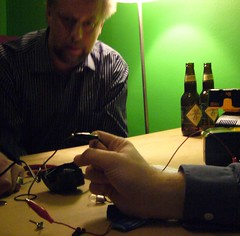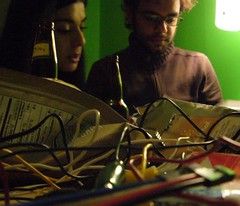 Our Sunday hack-afternoon resulted in not only a working roach coach, but also gear for a second backpack — a wifi repeater. In the process we — hilariously, but less dramatically this time — fried another NextNet modem.
Our Sunday hack-afternoon resulted in not only a working roach coach, but also gear for a second backpack — a wifi repeater. In the process we — hilariously, but less dramatically this time — fried another NextNet modem.
The team was me, Eli, Adam, Michael, Patrick, David and Jason. David brought a 12V motorcycle battery (off his motorcycle, which is hibernating this season), and Jason brought a little 12V rechargeable battery that he picked up at Active Surplus. Knowing that the motorcycle battery was already fully charged, we decided to hook the modem up to that one first. We tested the battery’s output voltage: 12.5V, safely in the 11-15V range that Tony recommended on our mailing list.
When we plugged it in the lights didn’t come on right away, as we would’ve expected. And there was a tiny little pop — we hoped it had come from a spark of the battery lead. We unhooked, and plugged the modem back into its wallwart… no luck, the modem was dead.
We tried diagnosing where we’d gone wrong… the only thing we came up with is that we’d reversed the polarity on the connector going into the modem.
That’s when we split up: one team would go fetch another NextNet modem, and the other team would start building backpack #2, a wifi-repeating backpack. The WRT54GL runs safely when plugged straight into our 18V cordless drill batteries.
 Patrick and Michael did a beautiful job converting the Ryobi flashlight. Patrick took the gear home to test out how long the 18V drill batteries will power a WRT54G. (UPDATE: Eight full hours, with torrents running on one of the wifi clients!)
Patrick and Michael did a beautiful job converting the Ryobi flashlight. Patrick took the gear home to test out how long the 18V drill batteries will power a WRT54G. (UPDATE: Eight full hours, with torrents running on one of the wifi clients!)
When we regained courage, we triple-checked the polarity on the connector, and plugged David’s 12V battery into the modem. (Though we used Jason’s modem this time — I was too chicken to risk blowing up mine for a third time in under a week.) It worked just fine! Then we tried plugging the modem and router into the battery at the same time — again, success!
The motorcycle battery is lead-acid, and probably not designed for deep cycle, making it a less than ideal choice: in terms of cost-efficiency, environmental-friendliness, and for the health and safety of the backpack’s wearer.
So we’ve yet to finalize a power source for the “backpack A”: the one containing both the NextNet modem and primary wifi router. We’ll either get some more Ryobi 18V drill batteries (so that we’re using the same power system for both backpacks) using a voltage regulator to knock it down to 12V, or we’ll use something like the Tekkeon myPower ALL MP3300. Anyone know of other (simple, inexpensive) options we should consider?
Once we’ve got the power stuff figured out, we’ll need to take it out onto the street, to see if we need to make any adjustments to the modem’s antenna, or add an external one…

 “Think of Lot 16 as the anti-Drake. Lifting its name from NYC’s Lot 61, the minimally appointed, very brown space was once the Elvis Restaurant, the greasiest of spoons. Though the current clientele has moved slightly upmarket – slightly – the no-frills Parkdale attitude remains.” — Now Magazine
“Think of Lot 16 as the anti-Drake. Lifting its name from NYC’s Lot 61, the minimally appointed, very brown space was once the Elvis Restaurant, the greasiest of spoons. Though the current clientele has moved slightly upmarket – slightly – the no-frills Parkdale attitude remains.” — Now Magazine Gusto Cafe is in Islington Village — a cute neighbourhood which I’d never been to until today. It seems like a great spot, offering coffee, snacks and sandwiches, and very friendly. It’s a short walk from the Islington subway… drop in if you’re in the area!
Gusto Cafe is in Islington Village — a cute neighbourhood which I’d never been to until today. It seems like a great spot, offering coffee, snacks and sandwiches, and very friendly. It’s a short walk from the Islington subway… drop in if you’re in the area! We started off well: we got a modem, router, two 18V Ryobi (cordless drill) batteries, a battery charger, and a 18V battery flashlight — from which we’d remove the light and plug into the two boxes. Patrick bought a nice blue backpack.
We started off well: we got a modem, router, two 18V Ryobi (cordless drill) batteries, a battery charger, and a 18V battery flashlight — from which we’d remove the light and plug into the two boxes. Patrick bought a nice blue backpack. So, we passed around another round of beers, and lamented. Ana-Maria — the only engineer among us — drew what we *should* have done… figured out the impedance of the router and modem, and added in the appropriate resistors to bring the voltage down to 13V. (Or this is what I think she said, anyway.)
So, we passed around another round of beers, and lamented. Ana-Maria — the only engineer among us — drew what we *should* have done… figured out the impedance of the router and modem, and added in the appropriate resistors to bring the voltage down to 13V. (Or this is what I think she said, anyway.) We’re happy to launch the first Wireless Toronto venue on the east side! The Renaissance Cafe serves coffee, food and is licensed, and hosts many spoken word and music events. 1938 Danforth Ave, one block west of Woodbine.
We’re happy to launch the first Wireless Toronto venue on the east side! The Renaissance Cafe serves coffee, food and is licensed, and hosts many spoken word and music events. 1938 Danforth Ave, one block west of Woodbine.